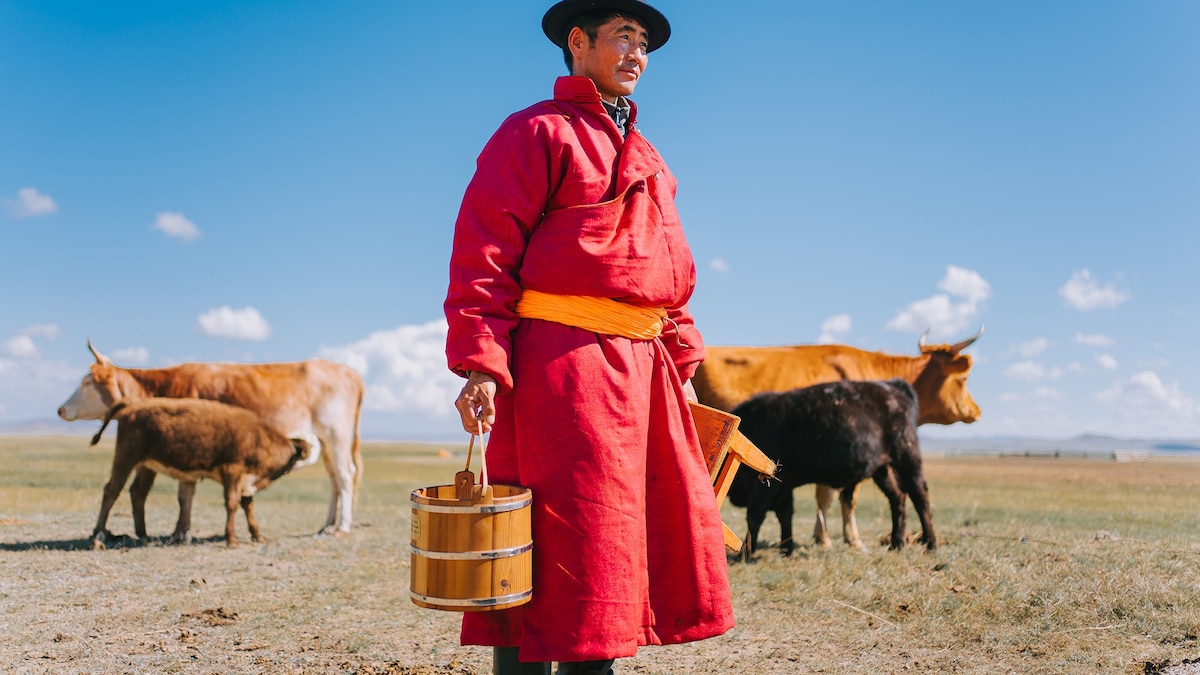This article was produced by National Geographic Traveller (UK).
It’s been two days since we left the glittering skyscrapers and flashy hotels of downtown Ulaanbaatar, Mongolia’s capital, and began our journey to the northeastern Khentii province — the birthplace of Chinggis (or Genghis) Khan, the founder of the Mongol Empire of the 13th and 14th centuries, the largest contiguous empire in history.
Driving through the Mongolian steppe, there are no roads to speak of, only sporadic tracks carved into the dirt by other vehicles. Out here, it’s just open landscape, horses, cows, yaks and other animals roaming free.
In the distance, nomadic gers (yurts) stand out like white dots in the vast rolling grassland. The sun is about to set when we reach our destination, the home of a nomadic herder family. Standing outside their ger, the steppe seems to stretch endlessly in all directions, making the world feel bigger but also somehow simpler. It’s only now that I feel I truly understand what they mean by the ‘endless blue sky’, a common epithet for the landlocked Northeast Asian nation. Mongolia is the second-least densely populated country in the world (after Greenland), with only two people per square kilometre. Given that more than half the population is crammed into the capital, the chances of running into another human being out on the steppe are remote.
My host, Batbayer, has a cheerful face, with deep creases and a leathery tan from long hours working outdoors, giving him the look of a sailor from an Ernest Hemingway novel. He lives with his wife, Enkhmaa, and together they tend livestock across the vast landscape.

Johan Nylander is the author of The Wolf Economy Awakens: Mongolia’s Fight for Democracy, and a Green and Digital Future.
Photograph by Allan Nylander
We had pre-arranged our visit but travellers in Mongolia can drive up to pretty much any ger and feel welcomed to stay. You don’t knock on the door: when approaching a nomadic family, a customary greeting is to utter a kindly “Hold your dog,” even if you don’t see a dog. Mongolia’s nomads are among the most hospitable, friendly people I’ve ever met.
We feast at the family home on one of the country’s most distinct and tasty dishes: khorkhog, or mutton cooked using hot rocks. This comes served with pickled cucumber, a variety of berries, and curdled milk — besides more plates of meat, all from the family’s own livestock. A bowl of vodka is passed around to share and constantly topped up. At midnight — to my great surprise — our hosts fire up a karaoke machine and we are soon all dancing to Kazakhstani pop hits and Mongolian love songs, played at full blast under the full moon.
Mongolia is home to one of the world’s few remaining truly nomadic cultures. About a fifth of the population are herders, and nomadism is intricately woven into the country’s spirit. But modern life is catching up with the people on the steppe at rapid speed. This is in large part what my book is about: an outsider’s exploration of a society undergoing modernisation while trying to hold fast to its deeply rooted traditional values.

Many of the livestock are implanted with microchips that can be monitored via satellite-based services.
Photograph by Timothy Allen, Getty Images
Batbayer’s ger has a TV, a satellite dish and some digital devices, powered using solar panels and a diesel generator, clear signs that technological transitions are afoot in the daily lives of Mongolia’s nomads. The sight of herders, on horses or camels, accessing the web or trading crypto via their smartphones is no longer as incongruous as it might sound.
Many of the livestock here, especially the more valuable breeds such as horses, camels and cattle, are implanted with microchips that can be monitored via satellite-based services. Herders are also increasingly using drones. Forget about today’s footloose information workers: these are the real ‘digital nomads’.
“I would like to use the internet more because it’s fun and useful; but the animals like it here, this is a good place for them,” Batbayer says when I ask if better internet connectivity might influence where to move his livestock next. “I would never choose Facebook over the wellbeing of the animals.”
The following day, we continue our journey deeper into the steppe and closer to the birthplace of the great Khan, an almost religious place for many locals. Hours spent driving over rough terrain is unlikely to appeal to those with sensitive bums. But for me, getting to know Mongolia by leaving behind modern comforts, to spend time with nomads on the vast steppe, or in the depths of the Gobi Desert, is a way to see the world, and oneself, from a very different perspective. Travelling through — and writing about — Mongolia has been very much an inner journey for this city-dwelling Asia correspondent.
Published in the May 2024 issue of National Geographic Traveller (UK).
To subscribe to National Geographic Traveller (UK) magazine click here. (Available in select countries only).





